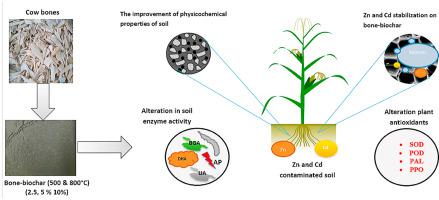Environmental Pollution ( IF 8.9 ) Pub Date : 2021-02-22 , DOI: 10.1016/j.envpol.2021.116800 Muhammad Azeem , Amjad Ali , Parimala Gnana Soundari Arockiam Jeyasundar , Yiman Li , Hamada Abdelrahman , Abdul Latif , Ronghua Li , Nicholas Basta , Gang Li , Sabry M. Shaheen , Jörg Rinklebe , Zenqqiang Zhang

|
Reusing by-products such as cow bones in agriculture can be achieved thorough pyrolysis. The potential of bone-derived biochar as a promising material for metals immobilization in contaminated mining soils has not yet been sufficiently explored. Therefore, cow bones were used as biochar feedstock were pyrolyzed at 500 °C (CBL) and 800 °C (CBH) and. The two biochars were applied to a mine contaminated soil at 0 (control), 2.5, 5 and 10%, w/w, dosages; then, the soils were incubated and cultivated by maize in the greenhouse. Cadmium (Cd) and zinc (Zn) bioavailability and their sequentially extracted fractions (acid soluble, reducible, oxidizable, and residual fraction), soil microbial function, and plant health attributes were analyzed after maize harvesting. Bone-derived biochar enhanced the content of dissolved organic carbon (up to 74%), total nitrogen (up to 26%), and total phosphorus (up to 27%) in the soil and improved the plant growth up to 55%, as compared to the control. The addition of CBL altered the acid soluble fraction of both metals to the residual fraction and, thus, reduced the content of Zn (55 and 40%) and Cd (57 and 67%) in the maize roots and shoots, respectively as compared to the control. The CBL enhanced the β-glucosidase (51%) and alkaline phosphatase activities (71%) at the lower doses (2.5–5%) as compared to control, while the activities of these enzymes decreased with the higher application doses. Also, CBL improved the antioxidants activity and maize growth at the 2.5–5% application rate. However, the activity of the dehydrogenase significantly decreased (77%), particularly with CBH. We conclude that CBL, applied at 2.5–5% dose, can be utilized as a potential low cost and environmental friendly amendment for stabilization of toxic metals in contaminated mining soils and producing food/feed/biofuel crops with lower metal content.
中文翻译:

在多金属污染的采矿土壤中,骨源生物炭改善了土壤质量并降低了Cd和Zn的植物利用率
通过热解可以实现农业副产品的再利用,例如牛骨。尚未充分探索骨衍生生物炭作为将金属固定在受污染的采矿土壤中的有前途的材料的潜力。因此,牛骨被用作生物炭原料,并在500°C(CBL)和800°C(CBH)下热解。将两种生物炭以0(对照),2.5、5%和10%(w / w)的剂量施用于受地雷污染的土壤;然后,将土壤在温室中培养并用玉米栽培。玉米收获后分析了镉和锌的生物利用度及其顺序提取的部分(酸溶,可还原,可氧化和残留部分),土壤微生物功能和植物健康属性。骨源生物炭提高了溶解有机碳的含量(高达74%),与对照相比,土壤中的总氮(最高26%)和总磷(最高27%)使植物生长提高了55%。与CBL相比,添加CBL可以将两种金属的酸可溶部分更改为残留部分,因此分别降低了玉米根和茎中Zn的含量(55%和40%)和Cd的含量(57%和67%)。控制。与对照相比,在较低剂量(2.5-5%)下,CBL增强了β-葡萄糖苷酶(51%)和碱性磷酸酶的活性(71%),而随着剂量的增加,这些酶的活性下降。此外,CBL以2.5-5%的施用量提高了抗氧化剂的活性和玉米的生长。但是,脱氢酶的活性显着降低(77%),特别是对于CBH。我们得出的结论是,CBL以2.5–5%的剂量施用,



























 京公网安备 11010802027423号
京公网安备 11010802027423号